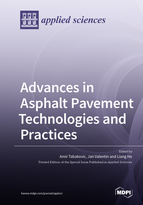Advances in Asphalt Pavement Technologies and Practices
A special issue of Applied Sciences (ISSN 2076-3417). This special issue belongs to the section "Civil Engineering".
Deadline for manuscript submissions: closed (1 September 2022) | Viewed by 52374
Special Issue Editors
2. Department of Materials, Mechanics, Management & Design (3Md), Faculty of Civil Engineering and Geosciences, Delft University of Technology, Microlab, Stevinweg 1, 2628 CN Delft, The Netherlands
Interests: self-healing technology for asphalt pavements; innovative solutions for asphalt pavement design; sustainable asphalt technologies and asphalt recycling
Special Issues, Collections and Topics in MDPI journals
Interests: pavement recycling; bitumen behaviour; asphalt mix design; asphalt mix testing; warm mix asphalts; cold recycling; waste materials usable for road engineering
Interests: pavement materials and maintenance; simulation of engineering materials; sustainable evaluation of pavement
Special Issues, Collections and Topics in MDPI journals
Special Issue Information
Dear Colleagues,
Unlike other construction materials, road materials have developed minimally over the past 100 years. However, since the 1970s, the focus has been on more sustainable road construction materials such as recycled asphalt pavements. Recycling asphalt involves removing old asphalt and mixing it with new (fresh) aggregates, binder, and/or rejuvenator. For the past two decades researchers have been developing novel material and technologies, such as self-healing materials, in order to improve road design, construction, and maintenance efficiency and reduce the financial and environmental burden of road construction.
This Special Issue on “Advances in Asphalt Pavement Technologies and Practices” aims to curate advanced/novel work in asphalt pavement design, construction, and maintenance. Topics include, but are not limited to:
- Sustainable asphalt pavement construction practices (e.g., recycling procedures).
- Biological materials in asphalt mix design.
- Life cycle analysis (modelling) environmental and economic risks of transport infrastructure.
Dr. Amir Tabakovic
Dr. Jan Valentin
Dr. Liang He
Guest Editors
Manuscript Submission Information
Manuscripts should be submitted online at www.mdpi.com by registering and logging in to this website. Once you are registered, click here to go to the submission form. Manuscripts can be submitted until the deadline. All submissions that pass pre-check are peer-reviewed. Accepted papers will be published continuously in the journal (as soon as accepted) and will be listed together on the special issue website. Research articles, review articles as well as short communications are invited. For planned papers, a title and short abstract (about 100 words) can be sent to the Editorial Office for announcement on this website.
Submitted manuscripts should not have been published previously, nor be under consideration for publication elsewhere (except conference proceedings papers). All manuscripts are thoroughly refereed through a single-blind peer-review process. A guide for authors and other relevant information for submission of manuscripts is available on the Instructions for Authors page. Applied Sciences is an international peer-reviewed open access semimonthly journal published by MDPI.
Please visit the Instructions for Authors page before submitting a manuscript. The Article Processing Charge (APC) for publication in this open access journal is 2400 CHF (Swiss Francs). Submitted papers should be well formatted and use good English. Authors may use MDPI's English editing service prior to publication or during author revisions.
Keywords
- asphalt recycling—hot, warm, cold
- rejuvenation
- bio-based binders and rejuvenators
- asphalt self-healing, roads construction and maintenance sustainability
- roads durability
- life-cycle analysis
- economy of roads








